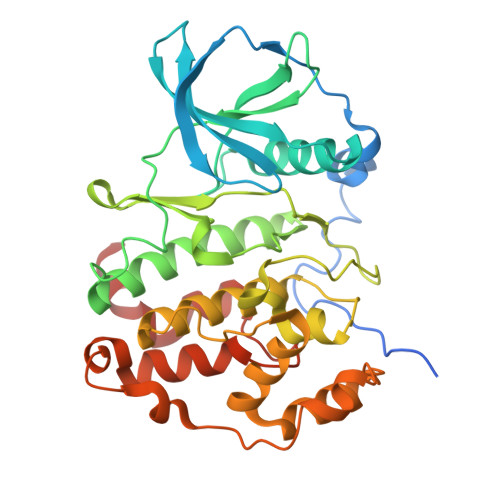Binding-Site Switch for Protein Kinase CK2 Inhibitors.
Grenier, D., Gelin, M., Yang, Y., Mularoni, A., Guichou, J.F., Delcros, J.G., Krimm, I.(2025) ChemMedChem 20: e202400868-e202400868
- PubMed: 39835439
- DOI: https://doi.org/10.1002/cmdc.202400868
- Primary Citation of Related Structures:
9HKP, 9HKS, 9HL0, 9HL7 - PubMed Abstract:
The serine/threonine protein kinase CK2, a tetramer composed of a regulatory dimer (CK2β 2 ) bound to two catalytic subunits CK2α, is a well-established therapeutic target for various pathologies, including cancer and viral infections. Several types of CK2 inhibitors have been developed, including inhibitors that bind to the catalytic ATP-site, bivalent inhibitors that occupy both the CK2α ATP-site and the αD pocket, and inhibitors that target the CK2α/CK2β interface. Interestingly, the bivalent inhibitor AB668 shares a similar chemical structure with the interface inhibitor CCH507. In this study, we designed analogs of CCH507 using structure-based and fragment-based approaches. The ability of these analogs to bind the CK2α/CK2β interface was evaluated using biolayer interferometry and fluorescence anisotropy-based assays. Their potency to inhibit CK2 kinase activity was determined using the bioluminescent ADP-Glo assay. These experiments allowed us to investigate which chemical modifications prevent the binding of the compounds at the CK2α/CK2β interface. Seven out of sixteen compounds conserved the ability to bind at the protein-protein interface, among which three compounds exhibited better interface inhibition compared to CCH507.
- Univ Lyon, Université Claude Bernard Lyon 1, INSERM 1052, CNRS 5286, Centre Léon Bérard, Centre de recherche en cancérologie de Lyon, Lyon, 69373, France.
Organizational Affiliation:



















